| SHOREBIRDS OF NORTH AMERICA |
|---|
| 6 Page Laminated Guide |
| Outside 3 Pages Opens to 11" by 25" |
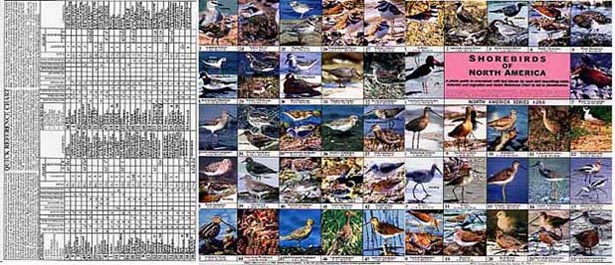 |
| SHOREBIRDS OF NORTH AMERICA |
|---|
| 6 Page Laminated Guide |
| Outside 3 Pages Opens to 11" by 25" |
 |
| Quick Reference Chart Outside page, 8" by 11". Folds inside. |
Back Page Folds to 8.5" by 11". |
Front Page Folds to 8.5" by 11". |
|---|
|
|
|
|---|---|
| Quick Reference Chart | |
| Close-up Of Upper Right Corner | Page Description |
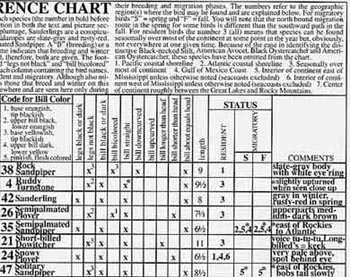 |
To the right is a close-up (actual size) of the Quick Reference Chart upper right corner. Although it looks complicated, the Chart simplifies shorebird identification tremendously. In a glance a check can be made of numerous basic shorebird characteristics such as leg color, bill color, overall length, location and range. This helps to narrow down the possibilities on the way to identifying a bird. Resident and migratory status is also identified. Not only is range given, but also where a bird is at a particular time of year. Numbers refer back to species' photos and text which are described belo w.
|
|
EXAMPLE OF HOW IT WORKS: You are on the Atlantic Coast in the month of May and see a brownish-gray shorebird (aren't they all?). He allows you a 2-3 second look before flying off. You only saw black legs and a black bill which was neither very short nor very long, assume it equals the head length. The chart shows the following matches: Sanderling, Semipalmated Sandpiper, White-rumped Sandpiper, Baird's Sandpiper and Red-necked Phalarope. To further narrow the list, you check the status of each and find both the White-rumped and Baird's are not found on the Atlantic Coast in May and that the Red-necked Phalarope is uncommon. Conversely, the Semipalmated Sandpiper and Sanderling are common where you are. Going one step further, you refer to the picture and text for each species and find that in May breeding plumage, Sanderlings are a conspicuous chestnut-red and Red-necked Phalaropes are slate-gray and rusty-red. Most likely your bird was a Semipalmated Sandpiper. |
|
| Typical Species' Photos | ||
| (Actual size approximately 1.7" by 2") | ||
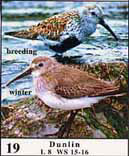 |
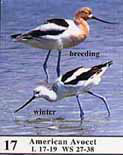 |
Length (L) and wing span (WS) statistics are listed under each species' common name. In the examples to the left both breeding and winter plumages are represented. This is done when plumages are significantly different. Numbers refer to species' text blocks on the publication inside pages (see below) and the Quick Reference Chart described above. 47 species of shorebird are included which represents all species collectively known as shorebirds commonly found on the North American continent north of Mexico. |
| Inside 3 Pages Opens to 11" by 25" |
|---|
 |
|
|
|
| Text Blocks | |
| (Actual size approximately 1.7" by 2.2") | |
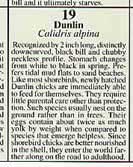 |
The first two inside pages contain text boxes (see sample to left) corresponding to each species pictured on the front. These provide common and scientific name, identification aids and usually something of the behavior traits and history of that shorebird species or shorebirds in general. SAMPLE OF WHIMBREL TEXT: Easy to recognize with its 3-4 inch sharply downcurved bill and striped crown. The Long-billed Curlew is similar but much larger, has a longer bill and lacks the striped crown. Like all shorebirds that probe into mud or sand 100's of times each day, the bill wears away especially at the tip. To combat this, the tip is constantly renewed as is the surface of the bill behind it. But if the bill is broken much in back of the tip, it will not grow back and the bird will starve. Whimbrels winter along all coasts of the continent and are not common inland except during nesting. |
|
|
|
| The Mystery of Shorebird Migration | |
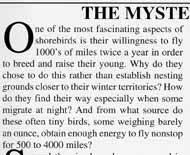 |
THIRD INSIDE PAGE:
WHERE TO FIND SHOREBIRDS:
|
| Sales Outlet |
|---|